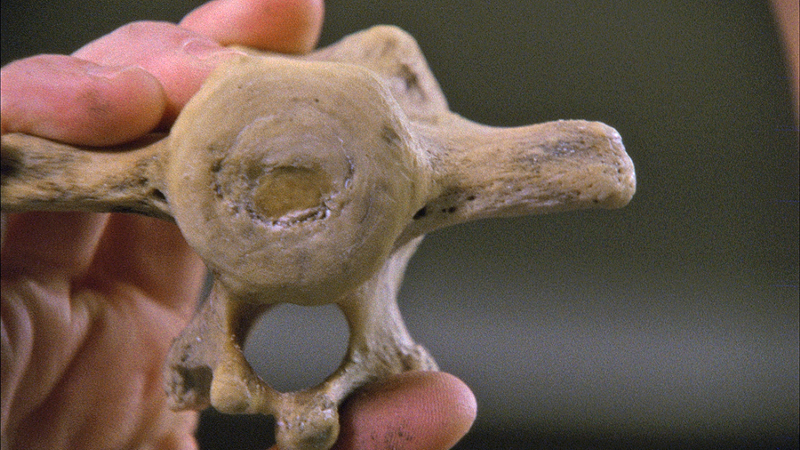
The 2013 film was made in Paris by two Puerto Rico-based artists: the Philadelphia-born Jennifer Allora and the Cuba-born Guillermo Calzadilla. Their idea was to photograph inside Paris’ National Museum of Natural History, with the camera moving steadfastly past the cavalcade of sometimes fierce-looking, sometimes terrified taxidermied animals in storage in its underground Zooteque. It also studies, with devoted detail, bones kept in this area.
But that’s just the half of it. The film also features a singing human being among these silent remains, vocalizing for his captive audience: Tim Storms, an American whose deep, low voice can hit a subsonic note that’s equivalent to eight octaves below the lowest G on a piano. (The artists/filmmakers of Apotome sent Wave Pool a special sound system with their digital print so visitors can hear some of Storms’ deepest and most gravelly vocal sounds.)
It’s a major achievement for the nonprofit Camp Washington-based Wave Pool to have this film, which is being shown on a loop during business hours until Animal Magnetism closes on Nov. 18. This is its first Midwest presentation, says Calcagno Cullen, Wave Pool’s executive director.
Cullen credits Animal Magnetism’s curator, University of Cincinnati associate Art History professor Kim Paice, for arranging it. The film shows upstairs from the main gallery, in a darkened room where Wave Pool has permanently installed a screen donated by artist Anthony Luensman.
When a film — even a 23-minute one like this — is this appealing to eyes and ears, you don’t need to care so much about the “why” of it. But actually that “why factor” adds to our understanding and appreciation of Apotome. In 1798, during the last days of the French Revolution, the nation brought two elephants to Paris from the Netherlands — Hans and Parkie — that the Dutch had themselves taken from what is now the Asian island nation of Sri Lanka.
The French treated them like royalty, if you could overlook the fact they were captive living things. As this was the age of Enlightenment, with its promise of Liberty, Equality, Fraternity, the French decided to serenade the two elephants with a concert. Might there be a bond between the two species — a love for music?
On Geri Walton’s excellent website — “unique histories from the 18th and 19th centuries” at geriwalton.com — she describes that performance: “On 29 May 1798, eleven musicians from the Conservatory of Music provided a concert for the two elephants as they dined. Among the pieces played was a piece in B minor from Gluck’s Iphigenia and an adagio from the opera Dardanus. The orchestra was arranged around a trap door so the elephants could not see them. When ‘everything was ready, and a profound silence reigned; the trap-door was noiselessly opened, and the concert began.’ The elephants responded with ‘curiosity, astonishment and anxiety.’ ”
In Apotome, Allora and Calzadilla, with Storms as their empathic accomplice, are channeling that performance. He is singing some of the same compositions that were performed for Hans and Parkie. After moving past the long-dead animals on display — a veritable zoo with zebras, monkeys, lions, bats and more — he inspects and sings to the bones of the elephants.
In some shots, the film just focuses on Storms’ face above the mouth. In others, the mouth doesn’t seem to move, so there’s a disembodied aspect to his voice. The film starts and ends with ultrasound images of his throat, but the image sort of looks like a face — a ghost in the machine.
This is when the power of Apotome really hits. Is this, like the original concert, a new attempt at enlightenment — a scientific experiment in what seems like a new age of ignorance? Or is it a requiem, a memorial to our inability, so far in history, to connect with and respect all species, including ourselves?
Animal Magnetism is on display through Nov. 18 at Wave Pool, 2940 Colerain Ave., Camp Washington. More info: wavepoolgallery.org.





